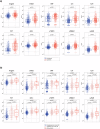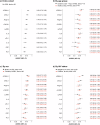Soluble triggering receptor expressed on myeloid cells 1 (sTREM-1) predicts mortality in patients with febrile illness in southern Mozambique
- PMID: 40715696
- PMCID: PMC12297511
- DOI: 10.1038/s43856-025-01014-2
Soluble triggering receptor expressed on myeloid cells 1 (sTREM-1) predicts mortality in patients with febrile illness in southern Mozambique
Abstract
Background: Fever is a leading reason for seeking healthcare globally. Early in the course of febrile illness, it is challenging to identify patients at risk of severe and fatal infections. Quantifying biomarkers of immune and endothelial activation may facilitate patient triage.
Methods: We prospectively enrolled children ≥2 months and adults with fever visiting two Mozambican hospitals from December 2018 to February 2021. Standard clinical and laboratory parameters, including lactate levels, were assessed at presentation. Plasma levels of Angpt-2, CHI3L1, CRP, IL-6, IL-8, PCT, sFlt-1, sTNFR1, sTREM-1, and suPAR at presentation were retrospectively quantified. Clinical outcomes were evaluated up to 28 days. We assessed the prognostic performance of biomarkers for 28-day mortality and explored their association with other adverse outcomes.
Results: This study includes 1955 participants, with 93 deaths occurring within 28 days. We show that all biomarker levels are elevated in inpatients compared to outpatients and are associated with 28-day mortality (all p < 0.001). sTREM-1 is the best biomarker predicting 28-day mortality with an AUROC of 0.82 (95% CI: 0.78-0.86), superior to that of PCT (p < 0.001), CRP (p < 0.001), and lactate (p = 0.0033). Its prognostic performance is consistent across age and sex, but is reduced in HIV-positive individuals (AUROC = 0.73, 95% CI: 0.66-0.80). Adding sTREM-1 improves the discrimination of clinical severity scores for 28-day mortality. Among discharged inpatients, sTREM-1 is positively correlated with duration of hospitalisation (p < 0.001). Among outpatients, sTREM-1 levels are higher in those seeking further care (p = 0.0022) or subsequently hospitalised (p = 0.012).
Conclusions: sTREM-1 is a promising biomarker for risk stratification of all-age, all-cause febrile illnesses in resource-limited settings.
Plain language summary
Fever is a common reason people seek healthcare, but at presentation it is often difficult to determine which individuals are at risk of becoming seriously ill. This study followed children and adults with fever presenting to hospital in Mozambique to assess whether measuring certain blood biomarkers could help identify those at risk of severe and fatal infections. One biomarker, called sTREM-1, was the best predictor of mortality and added prognostic information beyond usual clinical signs in both children and adults. sTREM-1 was slightly less accurate in HIV-positive patients but remained a good predictor. High levels of sTREM-1 were also linked to other adverse outcomes besides mortality. Measuring sTREM-1 could help healthcare workers in resource-limited settings recognize febrile patients who require closer monitoring or advanced treatment.
© 2025. The Author(s).
Conflict of interest statement
Competing interests: The authors declare the following competing interests: K.C.K. is a named inventor on a patent “Biomarkers for early determination of a critical or life-threatening response to illness and/or treatment response” held by the University Health Network. The remaining authors declare no competing interests.
Figures




References
-
- World Health Organization. WHO informal consultation on fever management in peripheral health care settings: A global review of evidence and practice. Geneva: World Health Organization, (2013).
LinkOut - more resources
Full Text Sources
Research Materials
Miscellaneous

